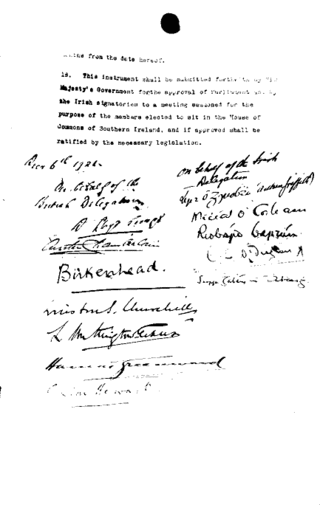Top Qs
Timeline
Chat
Perspective
Anglo-Irish Treaty Dáil vote
From Wikipedia, the free encyclopedia
Remove ads
The Anglo-Irish Treaty was signed in London on 6 December 1921 and Dáil Éireann voted to approve the treaty on 7 January 1922, following a debate through late December 1921 and into January 1922. The vote was 64 in favour, 57 against, with the Ceann Comhairle and 3 others not voting. The Sinn Féin party split into opposing sides in the aftermath of the Treaty vote, which led to the Irish Civil War from June 1922 to May 1923.
Remove ads
Background
Summarize
Perspective
Two elections took place in Ireland in 1921, as a result of the Government of Ireland Act 1920 to establish the House of Commons of Northern Ireland and the House of Commons of Southern Ireland. The election was used by the Irish Republic as the basis of membership of the 2nd Dáil. The general election to the Northern Ireland House of Commons occurred on 24 May. Of 52 seats, forty were won by unionists, six by moderate Irish nationalists and six by Sinn Féin. No actual polling took place in the Southern Ireland constituencies, as all 128 candidates were returned unopposed. Given the backdrop of the increasingly violent War of Independence, any candidates opposed to Sinn Féin and their supporters could expect to be harassed by the Irish Republican Army (IRA). Supporters of the Labour Party stood aside to allow the constitutional situation to run its course. Of these 128, 124 were won by Sinn Féin, and four by independent unionists representing Dublin University.
Only the Sinn Féin candidates recognised the 2nd Dáil and five of these had been elected in two constituencies, one in each part of Ireland, so the total number of members who assembled in the 2nd Dáil was 125.[1]
During the 2nd Dáil, the government of the Irish Republic and the British government of David Lloyd George agreed to hold peace negotiations. On 14 September 1921 the Dáil ratified the appointment of Arthur Griffith, Michael Collins, Robert Barton, Eamonn Duggan and George Gavan Duffy as envoys plenipotentiary for the peace conference in England. These envoys eventually signed the Anglo-Irish Treaty on 6 December. After almost a month of acrimonious debate the treaty was formally ratified by Dáil Éireann on 7 January 1922.
Remove ads
Vote
Summarize
Perspective

7 January 1922 Anglo-Irish Treaty Dáil vote Absolute majority: 63/124 | ||
| Vote | Votes | |
64 / 124 | ||
| No | 57 / 124 | |
| Absent | 3 / 124 | |
The Ceann Comhairle Eoin MacNeill absented himself from the vote in accordance with standing orders. It was ruled that the four other TDs, Michael Collins, Arthur Griffith, Éamon de Valera and Seán Milroy, who had been elected for two constituencies (for both the House of Commons of Southern Ireland and the House of Commons of Northern Ireland) would only cast one vote each. Of the 124 Teachtaí Dála (TDs) who were entitled to vote as a result of these rulings, 121 cast their vote in the Dáil, and three abstained. The result of the vote was: 64 in favour of the Treaty and 57 against. Three TDs eligible to vote did not do so:
- Frank Drohan resigned his seat on 5 January 1922, because he was personally anti-Treaty while his local Sinn Féin branch was pro-Treaty.[2]
- Laurence Ginnell (anti-Treaty) was absent in Argentina
- Thomas Kelly (pro-Treaty) was ill
Pro-Treaty
Anti-Treaty
Remove ads
Aftermath
Summarize
Perspective
To satisfy the requirements of the British constitution, the treaty also had to be ratified by the House of Commons of Southern Ireland. Thus Irish nationalists ended their boycott of the home rule parliament to attend the southern House of Commons as MPs. This they did alongside the four Unionist MPs who had refused to recognise the Dáil. In this way the treaty was ratified a second time in Dublin, this time unanimously as the anti-Treaty TDs refused to attend.
Under the terms of the Anglo-Irish Treaty a provisional parliament, considered by nationalists to be the 3rd Dáil, was elected in the 1922 general election on 16 June. Collins and de Valera agreed a pact between the pro- and anti-Treaty wings of Sinn Féin and this pact and the elections were endorsed by the 2nd Dáil.[5] The new assembly was recognised both by nationalists and the British Government and so replaced both the Parliament of Southern Ireland and the 2nd Dáil with a single body.
On 9 September 1922, Laurence Ginnell was the only anti-Treaty TD to attend the inaugural meeting of the Provisional Parliament or 3rd Dáil. Before signing the roll, Ginnell said:
- "I want some explanation before I sign. I have been elected in pursuance of a decree by Dáil Éireann, which decree embodies the decree of 20 May 1922. I have heard nothing read in reference to that decree, nothing but an Act of a foreign Parliament. I have been elected as a member of Dáil Éireann. I have not been elected to attend any such Parliament. Will anyone tell me with authority whether it is...".
He was at that point interrupted but resumed by saying that he would sign the roll and take his seat in the Assembly if the Assembly were Dáil Éireann. He was informed he was not allowed raise any such question until a Ceann Comhairle had been elected. He continued to ask questions regardless to which he got no answer including his question: "Will any member of the Six Counties be allowed to sit in this Dáil?"[6] W. T. Cosgrave moved at this point that he be excluded from the House. Ginnell protested, and he was dragged out by force.
Remove ads
See also
Footnotes
References
External links
Wikiwand - on
Seamless Wikipedia browsing. On steroids.
Remove ads